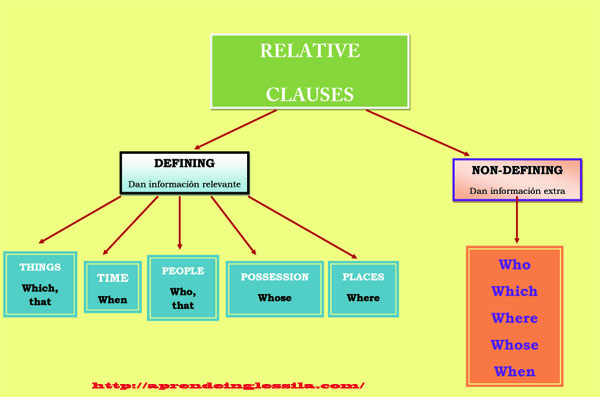NON-DEFINING RELATIVE CLAUSES

FUNCIÓN:
Una cláusula relativa no definitoria nos da información
adicional sobre un sustantivo.
La cláusula relativa podría eliminarse de la oración sin
afectar el significado básico.
A veces se puede usar para referirse a lugares.
Las "non-defining relative clauses" están
compuestas por un pronombre relativo, un verbo y otros elementos opcionales,
como el sujeto o el objeto del verbo. Siempre se emplean comas o paréntesis
para delimitar las oraciones de relativo no especificativas y separarlas del
resto de la oración principal.
FORMA:
Non-defining relative clauses:
|
|
·
Están separados del resto de la oración por comas.
·
Solo puede venir después del sustantivo al que se refieren.
|
The Charleston museum, which is the oldest museum in
the U.S., was built in 1773.
|
·
Solo se puede usar a quién hace referencia a las personas, y a qué se
refieren los lugares y las cosas.
·
A veces se puede usar para referirse a lugares.
|
Daniel Radcliffe, who played Harry Potter, now acts
in the theater. The college, which specializes in languages, is near New York
City. Seattle, where my parents live, is a very beautiful place.
|
PERSONA
|
COSA
|
LUGAR
|
|
Sujeto
|
Who
|
Which
|
-
|
Objeto
|
Who
|
Which
|
Where
|
Posesión
|
Whose
|
-
|
-
|
¡CUIDADO!
x Tchaikovsky, he wrote Swan Lake, was born
in 1840.
ü Tchaikovsky, who wrote Swan Lake, was born
in 1840.
x This car, that we bought last year, is
from Italy.
ü This car, which we bought last year, is
from Italy.
|
EJEMPLOS:
John's mother, who lives in Scotland, has 6
grandchildren.
My friend John, who went to the same school as me, has
just written a best-selling novel.
My grandmother, who is dead now, came from the North of
England.
We stopped at the museum, which we had never visited before.
I've just come back from London, where John lives.
Yesterday I met a
woman named Susan, whose husband works
in London.
EJERCICIOS:
Escribe oraciones con cláusulas de relativo no
definidas, usando la información dada.
1. - The Paris Opera Ballet is the oldest ballet company in
the world. It was founded in 1669.
The Paris Opera Ballet, which was founded in 1669, is
the oldest ballet company in the world.
2. – Harry Houdini was
born in 1874 in Budapest. He was a famous magician.
______________________________________________________________
3. – Swan Lake was based
on Russian folktales. It was written by Tchaikovsky.
______________________________________________________________
4. – The Sydney Opera
House was designed by Jorn Utzon. It opened in 1973.
______________________________________________________________
5. - The first opera was
called Dafne. It was performed in 1598.
______________________________________________________________
DEFINING RELATIVE CLAUSES
FUNCIÓN:
Las cláusulas
relativas definitorias nos dan información adicional sobre un sustantivo. No se
puede eliminar de la oración sin afectar el significado básico.
Como su propio nombre
indica, las "defining relative clauses" ofrecen información esencial
para definir o identificar a la persona o cosa de la que estamos hablando.
Las "defining
relative clauses" están compuestas por un pronombre relativo (que a veces
se omite), un verbo y otros elementos opcionales, como el sujeto o el objeto
del verbo. No se utilizan comas para separar la proposición relativa
especificativa del resto de la oración. Las comas o los paréntesis se emplean
para delimitar otro tipo de oraciones de relativo, las explicativas o
"non-defining relative clauses".
EJEMPLOS:
·
Children who hate chocolate are uncommon.
·
They live in a house whose roof is full of holes.
·
An elephant is an animal that lives in hot countries.
·
Let's go to a country where the sun always shines.
·
The reason why I came here today is not important.
Defining relative clauses:
|
|
No necesita comas para
separarlos del resto de la oración.
|
The movie which/that we saw
last week was directed by Martin Scorsese.
The director who/that won
the award not at the ceremony.
We stayed in the place where we
had our honeymoon.
|
Va detrás del nombre al que se refieren.
|
|
Puede usar which/that para referisrse a cosas.
Puede usar who/that to para referirse a
personas.
Puede usar where para referirse a lugares.
|
|
Subject and object relative clauses
|
|
Un sustantivo puede ser el
sujeto o el objeto de una cláusula relativa definitoria.
|
The actress who wore the
exquisite at the end of the movie is a model. (subject)
|
Cuando el sustantivo es el objeto de la
cláusula relativa, el pronombre relativo puede omitirse.
|
The
dress (that/which) the actress
wore at the end of the movie is exquisite. (object)
|
PERSONA
|
COSA
|
LUGAR
|
TIEMPO
|
MOTIVO
|
|
Sujeto
|
Who/That
|
Which/That
|
-
|
||
Objeto
|
Who/That
|
Which/That
|
Where
|
When
|
Why
|
Posesión
|
Whose
|
Whose
|
-
|
EJERCICIOS:
Lee las oraciones. Subraye la cláusula relativa definitoria y coloque una X al lado de las oraciones donde se puede dejar el pronombre relativo.
1. - The song which
plays at the end of the movie has been a big hit this summer.
2. – Look! He´s the actor who I was telling you about.
3. - The company that sold me the car has gone bankrupt.
4. - The Australian dancer who got the part is unknown in her home country.
5. - I recognized the famous landmarks which the
director used in several scenes.
6. - Do you remember the woman who promised to invite us to the party?






Very Well!
ResponderEliminar